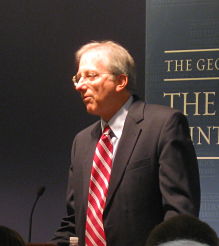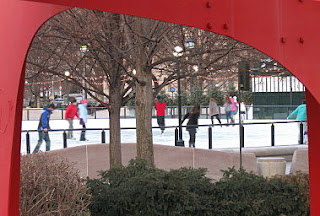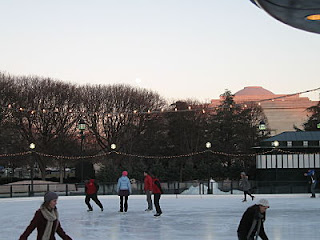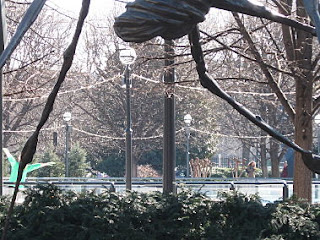Ambassador Dennis Ross speaking at the Elliott School of International Affairs, George Washington University/Patricia Leslie
He may be diplomat extraordinaire, but speaker extraordinaire, he ain't. I guess we can't have it all.
Ambassador Dennis Ross, formerly of this and that, is terribly smart and refined, evident in his address to a packed 150 person (more or less) SRO crowd Tuesday night at the Elliott School of International Affairs at George Washington University, one of my very favorite places to visit in this town (after the National Gallery of Art, natch).
He is knowledgeable, to be sure, confident and cocky, justifiably so.
His talk was entitled: "Challenges Ahead: America and the Middle East," but his monotone and lack of inflexion is on par with a row of humming refrigerators at the Home Depot.
That I'd had only five hours sleep for each of the two preceding nights contributed no doubt to my short naps while he talked, and thank goodness I was not so fast asleep that my body leaning over in the chair did not fail to jolt me from slumber when Ambassador Ross's tone crept higher than usual.
(On several occasions during the talk I was just glad I had not grabbed the leg of the young man sitting oh-so-close-next-to-me, to regain my balance before I fell upon the floor.)
What did the good ambassador say? Most of my words in my notes are scrunched together which is what happens when I sleep and write at the same time. They look like this: xzvxwpymnvxw but all squeezed together.
I don't think he said anything new really, delivering one of his stump speeches, but he likes sanctions and think they are effective although they take a long time to work.
 Ambassador Dennis Ross speaking at the Elliott School of International Affairs, George Washington University/Patricia Leslie
Ambassador Dennis Ross speaking at the Elliott School of International Affairs, George Washington University/Patricia LeslieCitizens of Middle East nations who have revolted have found solace in their mosques, Ross said, where they enjoy freedom of speech and assembly. In contrast to the regimes which have been and are being overthrown, the Muslim Brotherhood has identity, legitimacy, and lack of corruption, permitting the voices of the people to be heard. But the people have expectations and the Brotherhood "must find a way to deliver" soon, i.e., build houses.
One thing is for certain: The pathway to the Middle East's future is a known unknown. Who would have guessed?
I recall being impressed by every single question posed by the students in the Q and A which followed, but, unfortunately, at this point my notes were nothing more than blobs of ink which I can't make out to list.
I recall being impressed by every single question posed by the students in the Q and A which followed, but, unfortunately, at this point my notes were nothing more than blobs of ink which I can't make out to list.
The event was sponsored by the Institute for Security and Conflict Studies which presented the Security Policy Forum.
A few minutes before the good ambassador began speaking, my colleague Rashid called and offered me free tickets (near the ice!) to the Caps game. The Caps are My No. 1 Favorite Team, but, no, I told Rashid, I was at the Elliott School for International Affairs at George Washington University to hear Ambassador Ross's important talk which I absolutely was not going to miss.
I missed it all right: I missed one of the best games of the season. In the last period, Troy Brouwer erased the Caps' two-goal deficit with just moments to spare and tied the game to take it into OT when the now hot and flashy Ovie came roaring back, shot the puck between the legs of the New York Islanders' goalie, Evgeni Nabokov, and bam! Just like that! Victory snatched from "the jaws of defeat."
And that's the choice I made.
 Ambassador Dennis Ross speaking at the Elliott School of International Affairs, George Washington University/Patricia Leslie
Ambassador Dennis Ross speaking at the Elliott School of International Affairs, George Washington University/Patricia Leslie
.jpg)

.jpg)



















